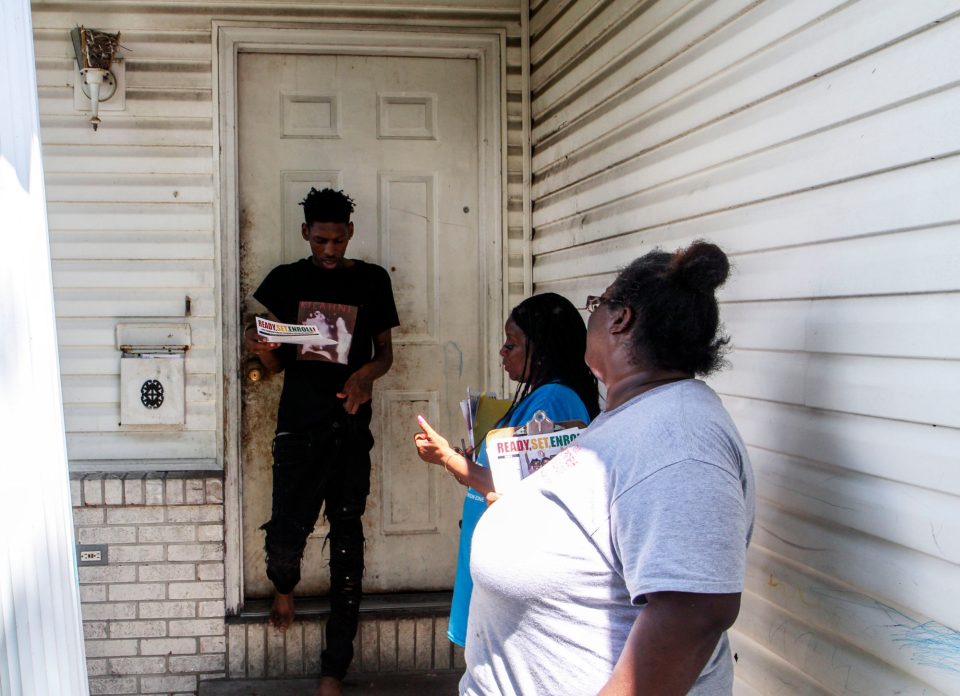
EAST ST. LOUIS, Ill. — Gloria Hicks steered her minivan through East St. Louis, passing the relics of a bigger, busier city: the abandoned high school whose halls Olympian Jackie Joyner-Kersee once walked, the weedy lot that once held the club where Ike and Tina Turner met, the boarded-up public housing complex where her own daughter once lived. But Hicks, 59, and the two mothers who were riding with her were looking for the city’s next generation.

Spotting a young woman pushing a stroller toward a bus stop, Hicks lurched to a stop and yelled for one of her passengers to jump out and catch up to the woman before she boarded the bus.
Not even the 100-degree weather deterred the three “parent ambassadors” from delivering their message to families: They should bring their young children to the Vivian Adams Early Childhood Center to have their development assessed and have them enrolled in pre-K.
The women were part of Ready, Set, Enroll, a campaign to improve the care of young children from low-income families, which is led by a coalition of child care providers, educators and social service agencies known as the Greater East St. Louis Early Learning Partnership. This coalition banded together to pull in grants for high-quality preschool and pre-K, and to recruit families to the programs.
East St. Louis, one of the country’s poorest cities, has been labeled the worst-performing school district in the nation. Only 73 percent of students graduate high school — compared to 89 percent in Illinois and 93 percent just across the river in Missouri. The lead poisoning and asthma rates here are some of the nation’s highest, and 43 percent of East St. Louis residents live below the poverty line. In a place where some neighborhoods have been labeled child care deserts because there are no child care centers, community leaders hope that improving early childhood education will reverse the city’s fortunes.
Top-notch early learning environments have been shown to improve academic outcomes for the most vulnerable children — even years later. However, most U.S. cities and towns, including East St. Louis, still lack the funding to provide high-quality programs for all the young children who need them. The federal government funds $10 billion in Head Start programs for low-income children directly, but they reach only about a third of children ages 3 to 5 living in poverty. The federal Preschool Development and Expansion Grant program has helped some states expand or improve early childhood programs, but the funding stream is relatively small, just $250 million. And while last year’s federal budget authorized a funding increase for the Child Care and Development Block Grant program, which allocates money to states to subsidize child care for children from low-income families, these federal funds often go to low-quality programs, with too few qualified staff, despite legal requirements that programs receiving funding meet certain standards.
Related: The state of American preschool
Other cities, such as New York and Washington, have built public preschool programs by raising local taxes, but with virtually no local funds to draw on, East St. Louis has been unable to do so. After an industrial heyday that peaked in the 1950s, East St. Louis lost nearly three-quarters of its businesses and dropped from more than 80,000 people to about 26,000 today. Half of its residents are out of work, and the city government is skeletal. As in other small cities and towns shedding population and industry, the city’s efforts to expand early care for children have been entirely dependent on state and federal funding, both of which fluctuate — when they exist at all.
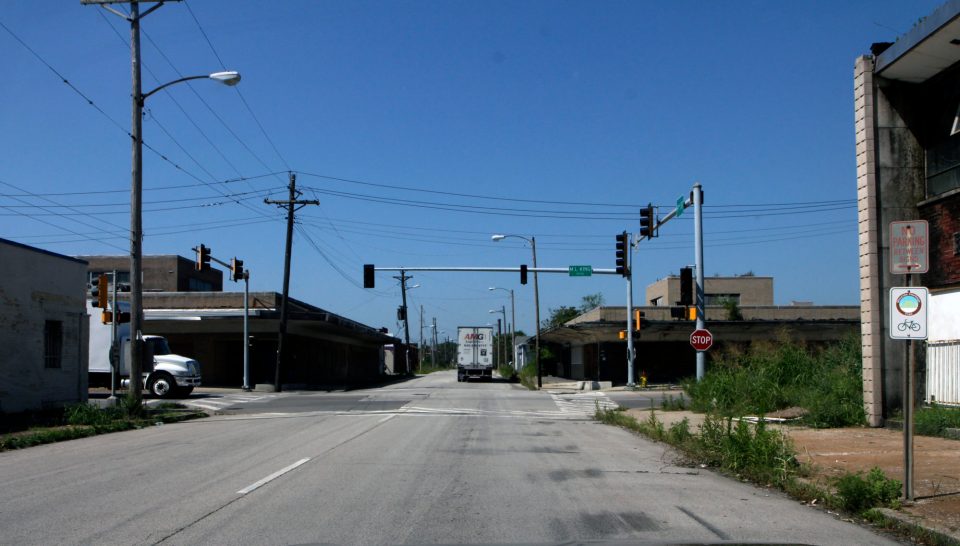
“There’s these fits and starts, with no consistent dedicated funding stream,” said Judy Reidt-Parker, director of national policy at the Ounce of Prevention Fund, a Chicago-based nonprofit that advocates for early childhood programs in low-income communities. “Federal funding is probably the largest financial footprint in states, but even then, it’s not nearly robust as it should be on a consistent, regular basis.”
The Early Learning Partnership’s shoestring efforts gained sudden momentum in 2013, when Illinois won a federal Race to the Top Early Learning Challenge grant. The state selected East St. Louis as an Early Childhood Innovation Zone, awarding the partnership its first significant funding, about $360,000 over three and a half years. The partnership decided to focus on getting more of East St. Louis’ youngest children into high-quality early childhood programs, those that use developmentally appropriate teaching practices, employ qualified staff and maintain low staff-child ratios.
Then, at the end of 2016, the Race to the Top funding expired. The partnership could no longer support its full-time coordinator and had to cobble together small local grants to hire a part-time coordinator for 15 hours per week. Whenever the partnership lacked funds for dedicated staff, its members — who all work full-time running day care centers or child welfare agencies — volunteered, divvying up the work and doing their best to squeeze it in around their other responsibilities. The “parent ambassador” outreach program was suspended for a year.
“The challenge is that, then the money goes away, and depending on where your state is and the resources they have available, not all that work continues,” said Ireta Gasner, vice president of Illinois policy at the Ounce of Prevention Fund.
Parent connections
A decade ago, East St. Louis native Joan Van’s first experience with an early childhood program left her anxious. Her oldest son’s preschool didn’t identify him as needing early intervention services, even though she voiced concerns that he had more trouble learning new skills than his peers. When he struggled in kindergarten, Van decided to hold him back, and — after a diagnosis of dyslexia and attention deficit hyperactivity disorder or ADHD — she finally secured special services for him through the school district. With extra support, he is now earning honors in his middle-school classes.
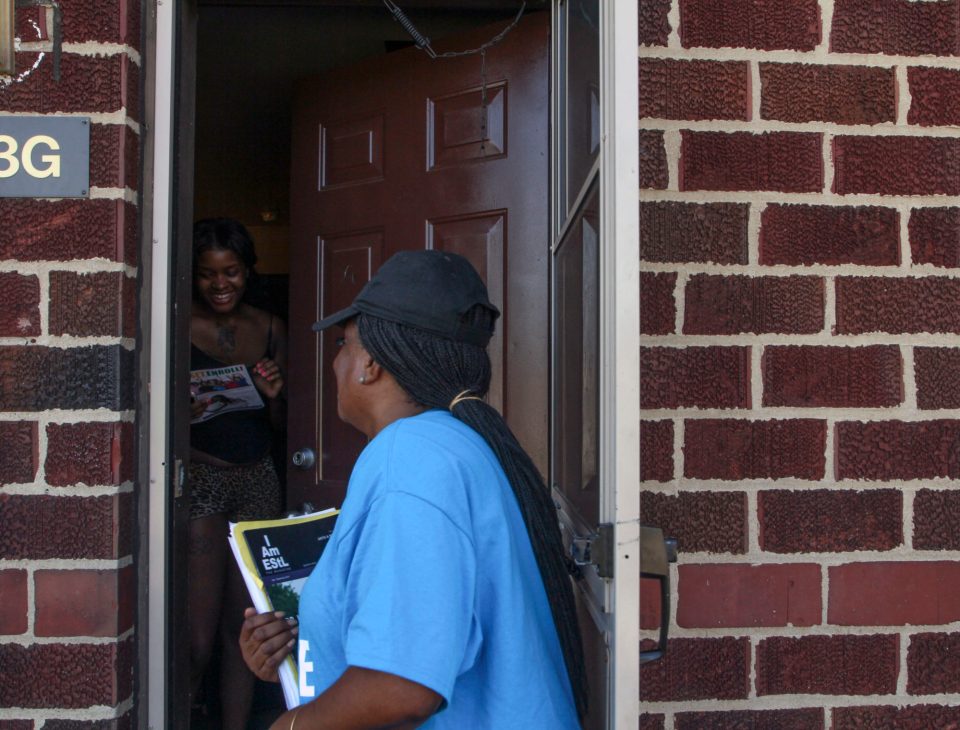
Experts say high-quality early education programs are not only critical to boosting academic preparedness, but also help families and schools catch problems early. In the East St. Louis school district, 15 percent of students have been diagnosed with a disability, which is on par with national numbers. Preschool and early intervention can help students to the point that many no longer need special education by the time they reach elementary school. In San Antonio, for example, children who attended a high-quality city-run pre-K were two-thirds less likely to be placed in special education.
Addressing this issue was one of the Early Learning Partnership’s chief goals when it developed the Ready, Set, Enroll campaign in 2015. Van, a stay-at-home mom, had initially been reluctant to put her 4-year-old daughter in preschool because of her experience with her son, but she said the new campaign, which includes early disability screenings, helped change her mind about the city’s preschool programs. “They have stepped their game up — they have improved a whole lot,” she said. “I’m glad that they listen to more parents and have the screening to be able to test these kids that have those minor disabilities.”
Van was so impressed, she became a parent ambassador herself. Every July, the ambassadors, who are paid $12 an hour, hit the streets to encourage parents to bring their children to the city’s main early childhood center to have their cognitive and motor skills assessed and their sight, hearing and dental health checked. As their children are examined, parents can apply to early childhood programs through a single streamlined application.
Related: In East St. Louis, the school district is helping parents get back on their feet
In 2014, before Ready, Set, Enroll, less than 1 percent of children age 5 and under in East St. Louis received special education services or early intervention services like speech therapy. In just five years, that number rose to about 4 percent of children.
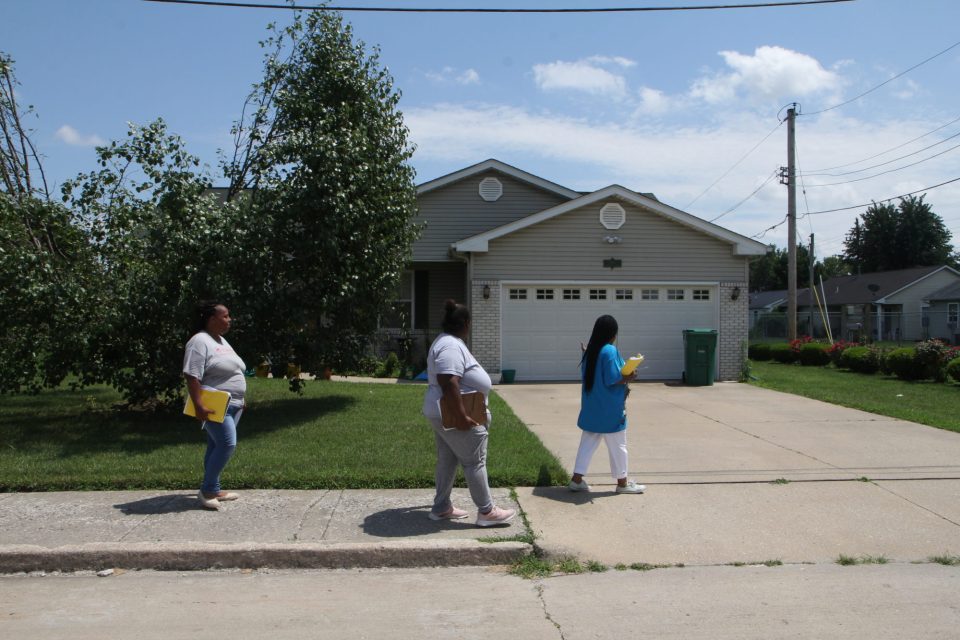
Part of the campaign’s success stems from the way it engages parents as partners in their child’s development. After knocking on one woman’s door, Van noticed the daughter didn’t respond to her mother unless she spoke loudly. Van encouraged the woman to bring her daughter to the enrollment center for a hearing test.
“Once we encouraged her, she was ready to do it and she did,” Van said.
Van’s role spreading the word about early childhood programs is no longer secure. Last year, without the Race to the Top funding, the partnership had to run the Ready, Set, Enroll campaign without parent ambassadors. Lacking the person-to-person outreach, the campaign reached fewer children, according to Janice Moenster, director of early childhood services for Children’s Home and Aid, a statewide service agency.
“We thought we could do it without them, and we found out we can’t,” said Brenda Crisp, founder and co-chair of the partnership. The parent ambassadors come from the same neighborhoods as the parents they’re trying to reach, she said, which can make them more approachable than educators.
This year, a $15,000 grant from the PNC Bank Foundation enabled the partnership to bring back the parent ambassadors.
‘We can relate to people’
Gloria Hicks — the tireless grandmother who drives the parent team around in her minivan and sets a blistering pace while canvassing as a parent ambassador — agrees that being part of the community is a key advantage. Once, she visited a home a social worker had tried and failed to reach several times. Seeing someone in an upstairs window, Hicks called out loudly to introduce herself and reassure them that no one was in trouble. “I didn’t talk to her like a social worker would,” she said. “The good thing about us doing it is we can relate to people better.” She succeeded in persuading the woman to come down to the door.
It wasn’t the only time her persistence paid off.
“One guy said he wasn’t ready to let his baby go because she’s only 3,” Hicks recalled. The man also worried that the child’s behavior was “bad.” Hicks told him, “There’s no such thing as bad. At 3, she should be in school learning and the teacher can teach her to calm down.”
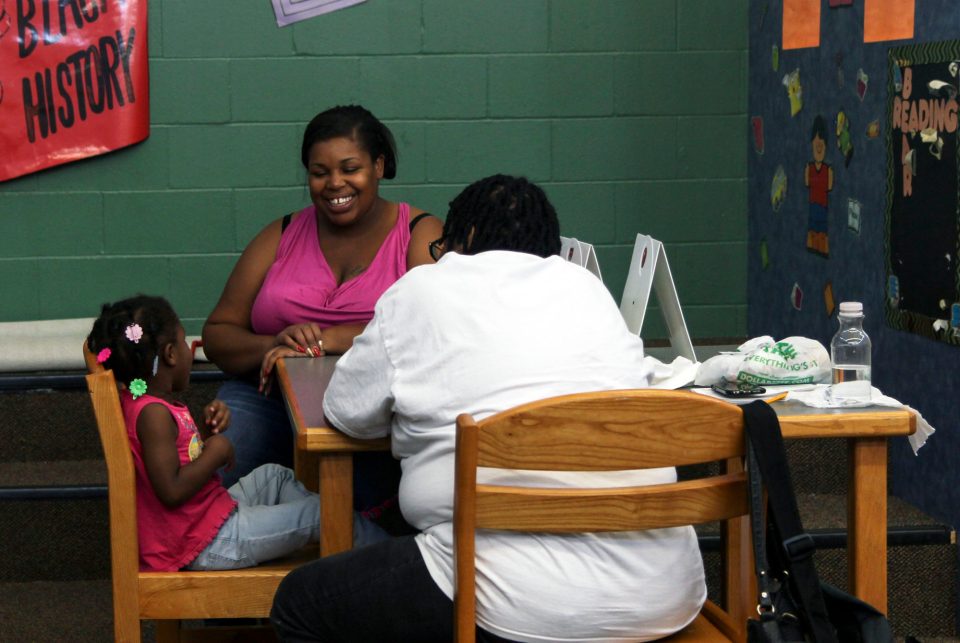
One of the parents the ambassadors recruited this summer was Jasma McCorkle. She wasn’t sure what preschool options were available for her 3-year-old daughter until the ambassador team made a stop at the facility for homeless mothers where she’d been living for close to a year. The ambassadors invited McCorkle, 30, and other mothers at the facility to the Ready, Set, Enroll center, arranging to bring them in a school bus so they wouldn’t have to make their way on their own. McCorkle decided to apply to a new pre-K center run by the school district because of its quality and proximity to the home she now lived in.
“As a first-time mom, it has me at ease a little more that she’ll be at a preschool rather than just a day care. It’s a little more educational,” McCorkle said. Also, she added, “I think the school uniforms are so cute.”
Backed by the data the partnership gathered, the school district last year received a $1 million state grant to open three new pre-K classrooms serving 60 children on the southeast side.
Parents in the new program, based at a local elementary school, say they are pleased. Whitney Roberson, 33, a native of central Illinois, admits that her husband’s stories about growing up in East St. Louis schools initially made her apprehensive about enrolling their 4-year-old son in pre-K.
“It surprised me because you have to go through a metal detector, which is something I’m not used to, but my husband said that’s normal here,” she said. “My son is in a safe environment, his teacher was great, it was like a little family.”
Quality on the line
Federal funding also enabled the Early Learning Partnership to shore up quality in the city’s existing programs. In 2013, Illinois created a state quality rating system that awards points to early childhood centers meeting certain standards, such as staff qualifications, safe facilities and age-appropriate teaching practices. By 2016, the partnership achieved its goal of helping 16 licensed child care centers earn state quality ratings.
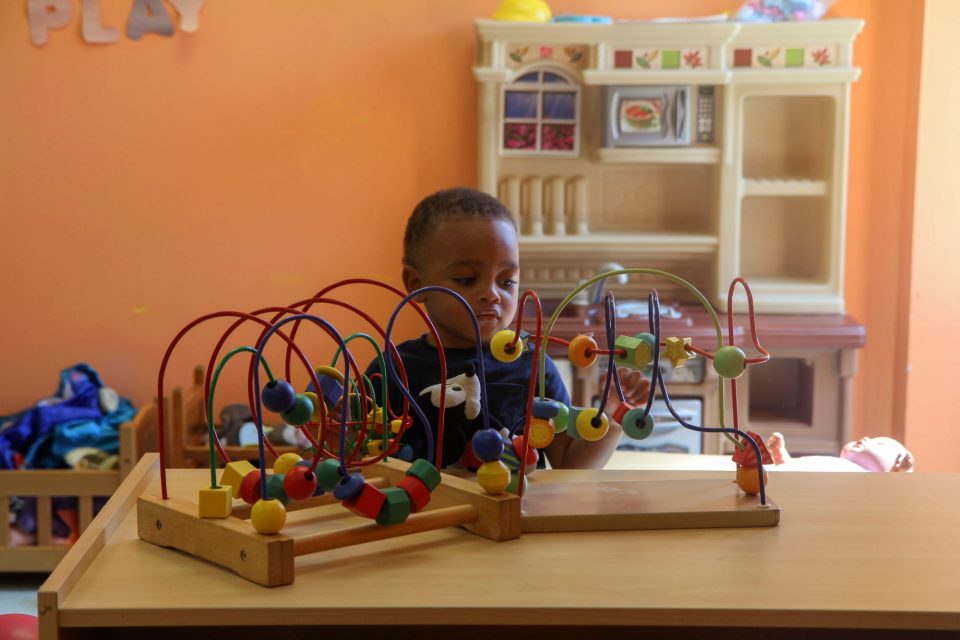
The quality ratings are good for both families and providers, who earn more for state-funded seats if they attain a silver or gold rating.
Meanwhile, an epic showdown in the Illinois state capitol had left the state without a budget for nearly two years. Among the hardest hit by the financial stalemate were child care providers serving children in low-income areas like East St. Louis, who relied almost entirely on state funding. Two of the centers that had earned a quality rating closed, and two others let their ratings lapse, which meant less training for teachers.
“We weren’t getting paid, people were upset, everyone was in survival mode, trying to make sure our programs could continue operating,” Crisp, the partnership’s co-chair, said. “Everyone kind of lost faith in everything that we worked so hard to get. We’ve been trying to get back. It’s been a struggle.”
East St. Louis providers hope they will receive more resources under the new administration of Gov. J.B. Pritzker, a billionaire philanthropist who has given millions of his own money to early learning programs. In July, he signed a budget that added $50 million in funding for Illinois’ Early Childhood Block Grant program, which funds preschool providers but not collaborative efforts like the partnership, and $100 million to fund construction and renovations of preschools.
The partnership is applying to more private foundations for funding to support two full-time employees, but nothing is certain. Without new funding, the partnership will lose its part-time coordinator in February. Still, partnership members are hopeful they’ll find a way to carry their collaborative work forward.
“We try to give parents as much support as we can,” Crisp said, “so that their lives will be a little more stable, so that their children’s lives become a little bit more stable and everyone can grow together and have a better life.”
This story about child care deserts was produced by The Hechinger Report, a nonprofit, independent news organization focused on inequality and innovation in education. Sign up for Hechinger’s newsletter.
*Correction: This story was updated to reflect that the funding for the research pilot was not provided by a Race to the Top grant.


